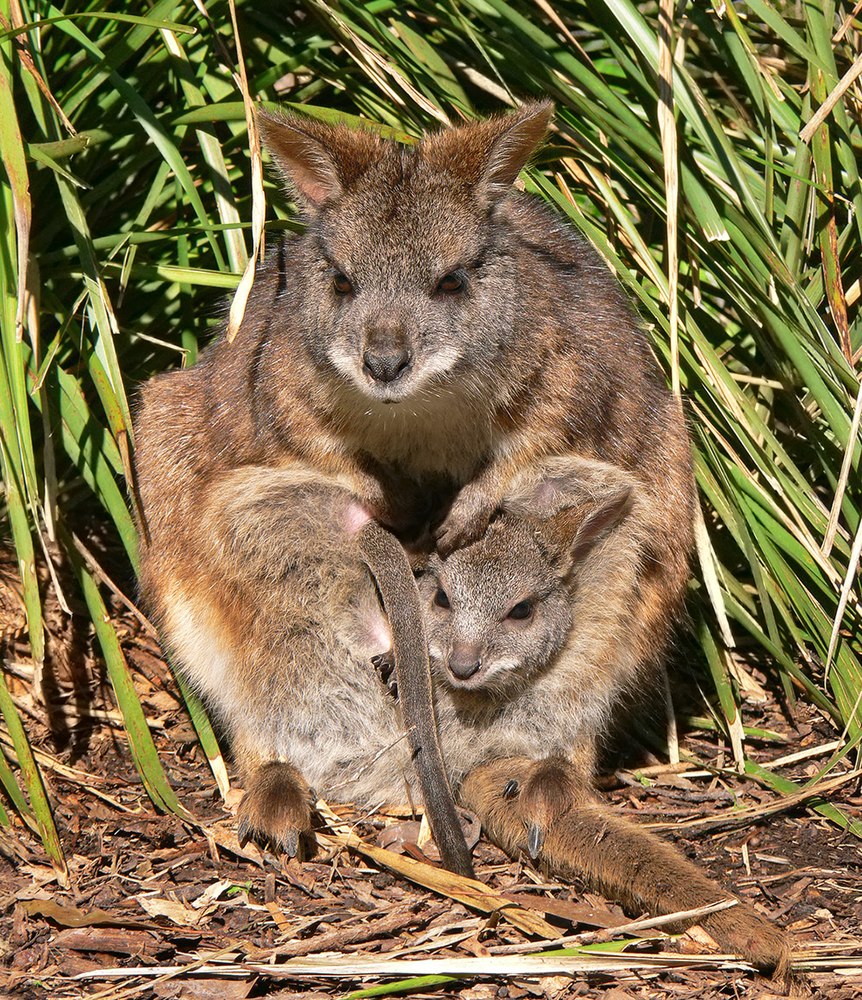How many baby Parma wallabys are in a litter?
A Parma wallaby (Macropus parma) usually gives birth to around 1 babies.With 1 litters per year, that sums up to a yearly offspring of 1 babies.
Each of those little ones spend around 34 days as a fetus before they are released into the wild. Upon birth, they weight 4 grams (0.01 lbs) and measure 2.6 cm (0′ 2″). They are a member of the Macropodidae family (genus: Macropus). An adult Parma wallaby grows up to a size of 87.7 cm (2′ 11″).
To have a reference: Humans obviously usually have a litter size of one ;). Their babies are in the womb of their mother for 280 days (40 weeks) and reach an average size of 1.65m (5′ 5″). They weight in at 62 kg (137 lbs), which is obviously highly individual, and reach an average age of 75 years.

The Parma wallaby (Macropus parma) was first described by British naturalist John Gould in about 1840. A shy cryptic creature of the wet sclerophyll forests of northern New South Wales (Australia), it was never commonly encountered and, even before the end of the 19th century, it was believed to be extinct. In 1965 workers on Kawau Island (near Auckland, New Zealand) trying to control a plague of introduced tammar wallabies (a widespread and fairly common species in Australia) were astonished to discover that some of the pests were not tammar wallabies, but a miraculously surviving population of Parma wallabies—a species long thought extinct. The extermination effort was put on hold while individuals were captured and sent to institutions in Australia and around the world in the hope that they would breed in captivity and could eventually be reintroduced to their native habitat.The renewed interest in the Parma wallaby soon led to another milestone: in 1967 it was found that they still existed in the forests near Gosford, New South Wales. Further investigation showed that the Parma wallaby was alive and well, and although not common, was to be found in forests along the Great Dividing Range from near Gosford almost as far north as the Queensland border.The offspring of the Kawau Island population are smaller than their fully wild relatives, even when provided with ample food: it appears that competition for limited food resources on the island selected for smaller individuals, an incipient example of the phenomenon of insular dwarfism.
Other animals of the family Macropodidae
Parma wallaby is a member of the Macropodidae, as are these animals:
- Eastern hare-wallaby with 1 babies per pregnancy
- Spectacled hare-wallaby with 1 babies per pregnancy
- Dingiso weighting around 9.4 kilograms (20.72 lbs)
- Black-flanked rock-wallaby with 1 babies per pregnancy
- Banded hare-wallaby with 1 babies per pregnancy
- Black wallaroo with 1 babies per pregnancy
- Black dorcopsis with 1 babies per pregnancy
- Tasmanian pademelon with 1 babies per pregnancy
- Gray dorcopsis with 1 babies per pregnancy
- Macleay’s dorcopsis with 1 babies per pregnancy
Animals that share a litter size with Parma wallaby
Those animals also give birth to 1 babies at once:
- Rhim gazelle
- Alpine ibex
- Broad-striped Malagasy mongoose
- Pel’s pouched bat
- Fire-bellied brush-furred rat
- Angolan epauletted fruit bat
- Rough-haired golden mole
- Black crested gibbon
- Fallow deer
- Puna mouse
Animals that get as old as a Parma wallaby
Other animals that usually reach the age of 10 years:
- Pacarana with 9.33 years
- Bushveld elephant shrew with 8.75 years
- Masoala fork-marked lemur with 12 years
- Spectral tarsier with 12 years
- Mindanao treeshrew with 11.5 years
- Little pocket mouse with 8.25 years
- Pygmy hog with 12 years
- Whiskered bat with 9.25 years
- Waterhouse’s leaf-nosed bat with 10.42 years
- Asian small-clawed otter with 10.08 years
Animals with the same weight as a Parma wallaby
What other animals weight around 4.16 kg (9.17 lbs)?
- Masked palm civet usually reaching 4.3 kgs (9.48 lbs)
- Greater cane rat usually reaching 3.75 kgs (8.27 lbs)
- European wildcat usually reaching 4.53 kgs (9.99 lbs)
- White-tailed mongoose usually reaching 3.66 kgs (8.07 lbs)
- Pampas fox usually reaching 4.54 kgs (10.01 lbs)
- Rothschild’s rock-wallaby usually reaching 4.55 kgs (10.03 lbs)
- Thick-spined porcupine usually reaching 4.59 kgs (10.12 lbs)
- Blue duiker usually reaching 4.86 kgs (10.71 lbs)
- Gray dorcopsis usually reaching 4.95 kgs (10.91 lbs)
- Asian small-clawed otter usually reaching 3.53 kgs (7.78 lbs)
